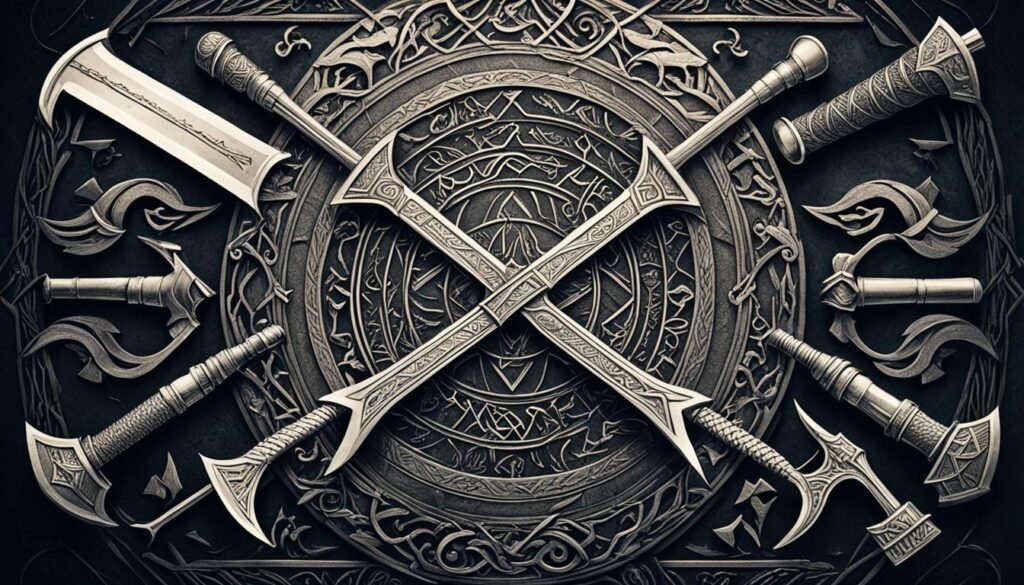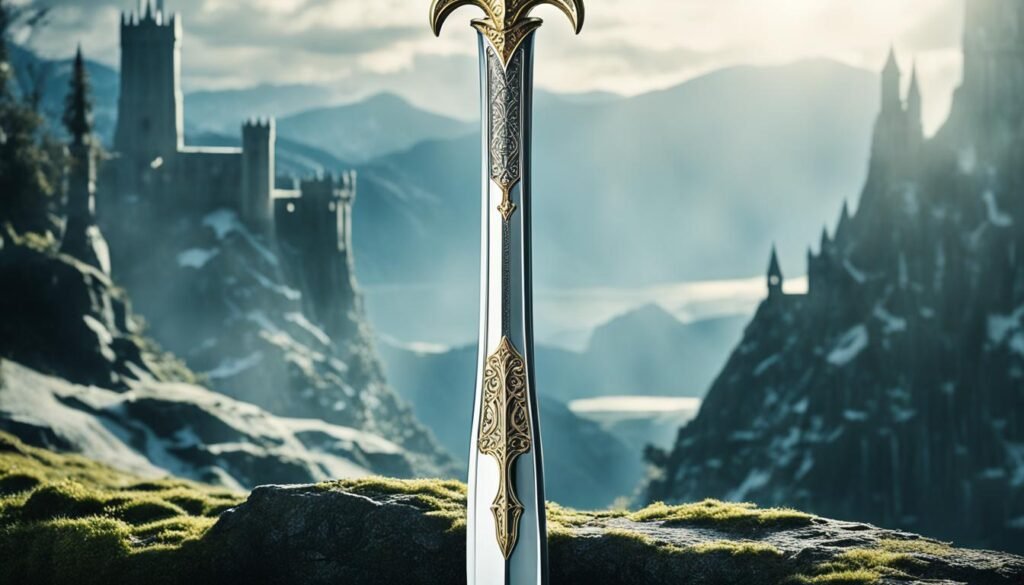Mythical Weapons : From sacred spears to magical hammers, mythical weapons are key in many stories. They have a long history that makes them important. These items are often linked to gods, making their users capable of great feats. This article looks at legendary weapons from different cultures. It explains their role in shaping our storytelling traditions.
Key Takeaways : Mythical Weapons
- Mythical weapons hold a prominent place in various cultural mythologies and folklore.
- These weapons are often imbued with supernatural powers and connected to legendary figures or deities.
- The cultural significance of mythical weapons extends beyond their physical attributes, representing ideals such as honor, bravery, and heroism.
- Examining the history and legacy of mythical weapons provides insight into the storytelling traditions and belief systems of diverse civilizations.
- The enduring popularity of mythical weapons in modern media and entertainment reflects their timeless appeal and ability to captivate the human imagination.
The Power of Mythical Weapons in Ancient Greek Mythology
In Greek mythology, gods wielded powerful weapons beyond mortal imagination. These divine tools not only boosted the Olympians’ strength but also elevated their status. Notable ones include Cronos’ sickle, Zeus’ lightning bolt, Poseidon’s trident, and Hades’ helm of invisibility.
Cronos’ Sickle: The Harbinger of Chaos
Cronos, a Titan ruling the universe, had a mighty sickle. He used it to defeat his father, Uranus, showing the chaos in their world. The sickle started the Titans’ fall and the rise of the Olympians.
Zeus’ Lightning Bolt: The Ultimate Symbol of Might
Made by the Cyclopes, Zeus’ lightning bolt displays his unmatched power. It helped Zeus win the battle against the Titans, showing his control over nature. This Greek myth highlights Zeus as the most powerful in the divine world.
Poseidon’s Trident and Hades’ Helm: Catalysts for Victory
Zeus’ lightning bolt was important, but so were Poseidon’s trident and Hades’ helm of invisibility. Poseidon’s trident ruled the seas, while Hades’ helm made him unseen. These Greek mythology mythical weapons helped the gods defeat the Titans, making them the new rulers.
“The gods of Olympus are more than mere legends. They are the embodiment of the forces that shape our world, and their weapons are the tools that forge their destinies.”
Divine Armaments: Mythical Weapons Bestowed upon Heroes
In the captivating realm of Greek mythology, gods sometimes gave their powerful weapons to heroes. This gave mortals a way to do extraordinary things. For instance, the shield of Athena and the winged shoes of Hermes went to the heroic Perseus.
Athena’s Shield and Hermes’ Winged Shoes: Empowering Perseus
Young Perseus was on a mission to defeat the Gorgon Medusa. Athena and Hermes helped him in his quest. Athena gave her famous reflective shield to Perseus. It allowed him to look safely at Medusa without turning to stone.
Hermes, who was known for his speed, gave Perseus his own winged sandals. This gift let Perseus move quickly and dodge Medusa’s gaze. With these items, Perseus was ready to face Medusa with skill and speed. He triumphed by cutting off her head.
With the mythical weapons, Perseus had from the gods, he showed that impossible tasks could be done. This story highlights the strong bond between humans and gods in Greek mythology.
“The gods occasionally lent out their powerful weapons to mortals who held their favor, bestowing blessings and fortune to their chosen heroes.”
Through the mythical weapons from the gods, Perseus could accomplish great deeds. This tale shows the profound influence of divine armaments on human fate in the fascinating Greek mythology.
Achilles’ Armor and Shield: Forged by the Gods
In Greek mythology, Achilles was given famous divine weapons. These items, known from the Iliad, were made by the god of forge, Hephaestus. Achilles wore them in the story.
When Achilles lost his friend Patroclus, his mother Thetis asked Hephaestus to make new armor. This armor was special. It showed both peaceful scenes and scenes of war.
The shield is described in the Iliad as wondrous. It had images of the sea, the sky, the sun, moon, and stars. Even constellations like the Bear and Pleiades were on it. This showed the armor was no ordinary piece.
Achilles’ armor and shield were more than just for protection. They tied him to the gods, making him special. They represented his bravery in the Iliad and the Trojan War. They made him a hero.
The Iliad beautifully describes Achilles’ armor and shield. They have been re-told for years, showing their importance. These items symbolize the close relationship between gods and people in ancient Greek myths.
The Iconic Weapons of Norse Mythology
The Norse pantheon is filled with rich mythology that sparks the imagination. It’s led to stories of brave acts and supernatural powers. Among the iconic parts are the weapons of gods and heroes. Thor’s hammer, called Mjolnir, and Odin’s spear, known as Gungnir, stand out. They are deeply ingrained in our cultural stories.
Thor’s Hammer – Mjolnir: The Thunderous Companion
Thor, the god of thunder, is famous for his hammer, Mjolnir. Skilled dwarves made this hammer for him. It came back to Thor’s hand when thrown. This hammer could summon lightning and defeat powerful enemies. Mjolnir symbolizes Thor’s strength, bravery, and control over storms. It’s a key part of Norse mythology mythical weapons.
Odin’s Spear – Gungnir: The Relentless Thrust
Odin, the chief god, wielded a spear named Gungnir. This spear always hit its target. Odin could use Gungnir to deal powerful blows. It shows Odin’s leadership and the might of his Thor’s hammer Mjolnir and Odin’s spear Gungnir.
These weapons made the gods even stronger and stand as symbols of their might. They shaped Norse culture and faith. Mjolnir and Gungnir still fascinate us today. They represent the everlasting power of these legendary weapons.
“The hammer, Mjolnir, was imbued with the power to summon lightning and crush even the mightiest of foes.”
Odin’s Sword: Bestowing Heroic Virtues
In the world of Norse mythology, gods often gave great weapons to humans they thought were brave and worthy. One famous weapon was Odin’s sword. It was a key part of the Völsung saga, a story about heroes, betrayal, and the power of the human heart.
In the saga, Odin, chief of the gods, visited a feast in disguise. He stuck a superb sword into a tree and dared anyone to pull it out. Only Sigurd, a young man, succeeded. This act made Sigurd not just a hero but someone destined for great things.
“Odin’s sword, once drawn, can never be sheathed until it has tasted blood.” – The Völsung Saga
In Norse mythology, heroes gaining divine weapons linked them to deeper universal powers. By getting Odin’s sword, Sigurd became a legendary figure. This sword signified the gods’ favor and a great future for him. It showed his heroic traits and they led him to his destiny.
The tale of Odin’s sword in the Völsung saga shows the immense value Norse mythology put on divine weapons. These legendary arms were more than equipment for battle. They were blessings from the gods. They held the power to change fates and help heroes do extraordinary things.
Mythical Weapons in Medieval Europe
In medieval Europe, stories of mythical weapons were common, but they changed a bit. The story of Excalibur, King Arthur‘s sword, is one of the most famous. Legend says only the true king of Britain could pull Excalibur from a stone. This act showed Arthur was rightfully chosen to lead.
Excalibur was said to be special, with its own magic. It represented Arthur’s might and fairness as a ruler. Because of this, Excalibur is still known today. It appears in many tales and movies about the Arthurian legends.
Excalibur: The Sword of Righteous Kingship
Excalibur was a key part of the medieval mythical weapons scene. It was known for its great power and what it stood for. As King Arthur‘s sword, Excalibur symbolized just and noble rule.
The tale of how Arthur gained Excalibur is important in the Arthurian legends. Pulling the sword from the stone proved Arthur’s right to rule. After this, Excalibur‘s magic showed Arthur was meant to be king. Its blade could not be broken, and it could defeat any enemy.
The story of Excalibur lives on in many ways. Movies, books, and games still include this famous sword. They show us the idea of a great and brave king fighting against evil. This theme has always been popular and still is today.
The Masamune: A Blade of Honor and Artistry
The Masamune sword is legendary in Japanese sword-making. It’s named after its creator, Goro Nyudo Masamune. This sword is an icon of samurai culture. Each one is a masterpiece, showing the amazing skill of its maker.
Masamune used special methods to make these blades perfect. They were important in Japanese history, showing both bravery and beauty. The sword is a key part of the samurai code.
| Characteristic | Description |
|---|---|
| Blade Design | The Masamune swords were known for their perfect design. They had a special curve and a very sharp edge. They were beautiful and also very good for fighting. |
| Forging Technique | Masamune was a master at using old Japanese ways to make swords. These ways made the swords really strong and likely to last a long time. |
| Cultural Significance | The Masamune sword was more than just a weapon. It stood for the samurai’s strong commitment to their duty and honor. It shows the best of Japanese sword-making and samurai culture. |
Even today, the Masamune sword is admired all over the world. It represents the lasting value of hard work, skill, and the search for perfection.
“The Masamune sword is not just a weapon; it is a work of art, a symbol of the samurai’s unwavering dedication to duty and honor.”
Durandal: The Sword of Bravery and Chivalry
The legendary Durandal sword has a big part in Carolingian legends. It was wielded by Roland, who fought with Charlemagne. In “The Song of Roland,” it was given to Charlemagne by an angel and then to Roland.
Durandal is a key part of France’s culture. It stands for bravery and chivalry of the Carolingian time. The Durandal sword is famous for the Battle of Roncevaux Pass.
“When Durandal, my good sword, is brandished, it shines like a sunbeam, it dazzles like lightning. Its blade is forged from the finest steel, and can cut through the hardest of substances.”
– The Song of Roland
The Durandal sword is a symbol of its time. It shows the strength and honor of the Carolingian era. This sword’s stories are still told, keeping its memory alive.
| Weapon | Owner | Significance |
|---|---|---|
| Durandal sword | Roland | Epitomizes the values of bravery and chivalry in the Carolingian legends |
Joyeuse: The Joyous Sword of Charlemagne
The famous Joyeuse sword was made by the skilled Galas. It’s at the heart of Carolingian legends. This special sword belonged to the great Charlemagne, King of the Franks. He used it with great strength.
Galas spent three years creating Joyeuse. He put all his best work into it. The sword was more than just a weapon. People thought it had magic powers, like changing colors thirty times a day. This showed the mood of the battlefield changing.
Joyeuse was really important to Charlemagne. It showed his power and ability in fights. This sword always stood by him, showing his strength, wisdom, and the lasting spirit of his family.
“Joyeuse, the sword of Charlemagne, was a symbol of his power and the might of the Frankish kingdom. Its legendary status has endured through the ages, a testament to the enduring legacy of this extraordinary weapon.”
The Joyeuse sword keeps the magic of ancient weapons alive. It’s tied to tales about the great Charlemagne and the Carolingian legends. That’s why it’s one of the most famous swords in history.
Mythical Weapons: Embodiments of Cultural Ideals
Mythical weapons have always been more than tools for battle. They’re symbols of what different societies believe in and strive for. For example, the sickle of Titan Cronos and the hammer of the Norse god Thor represent chaos and power. They let their users control huge forces and do amazing things. These stories have greatly influenced our myths and legends.
Blades like Excalibur, Durandal, and Joyeuse stand for good leadership and bravery. They show what their cultures value. These swords are more than just weapons; they are keys to stories of heroes. Stories that help us explore what it means to be human and search for our purpose.
Diving into the story of these cultural significance of mythical weapons teaches us much. We learn about the human wish to give deeper meanings to the world around us. These mythological weapons in history show what we truly hope and fear. They help us understand life and connect with our ancestors’ stories.
“Mythical weapons are not merely tools of war, but rather, they are vessels that carry the weight of our collective symbolic meaning of legendary swords and aspirations. They are the physical embodiment of our most cherished values and beliefs.”
Studying cultural significance of mythical weapons brings us back to their powerful stories. Through time, these legendary items have inspired us to do great things. They were tools of heroes or emblems of great civilizations. They remind us of our courage, strength, and our spiritual journey.
Also Read : How English Became World’s Most Powerful Language?
Conclusion: The Enduring Legacy of Mythical Weapons
From ancient Greek and Norse mythos to Medieval European tales, mythical weapons have always fascinated us. They’re more than just tools for war. They stand for cultural values and connect us to heroes from the past. These objects carry the power of gods and shape our storytelling traditions.
Think about Zeus’ lightning bolt, Thor’s hammer, or Excalibur. They have a lasting impact on how we think. They symbolize our wishes for courage, honor, and something greater than us. By looking at their history and impact, we learn more about being human. We understand why tales of the extraordinary never lose their appeal.
Legendary swords and mythological arms still capture our imaginations. They show us how powerful stories and myths can be. Each tale takes us to a place where gods and humans meet. It makes the extraordinary seem close to our everyday world.
FAQs
What are some of the most famous mythical weapons in ancient Greek mythology?
In Greek mythology, famous weapons are Cronos’ sickle, Zeus’ lightning bolt, Poseidon’s trident, and Hades’ helm.
How did mythical weapons connect mortals to the divine in Greek and Norse mythology?
Athena’s shield and Hermes’ shoes linked mortals to gods, giving divine power. Similarly, Odin’s sword bestowed mighty abilities.
What is the significance of Achilles’ shield in Homer’s Iliad?
Achilles’ shield was made by Hephaestus. Homer praised it for showing daily life. It symbolized divine connection and heroism.
What are some of the iconic mythical weapons from Norse mythology?
Thor’s Mjolnir and Odin’s Gungnir are iconic in Norse mythology. They were powerful symbols of the gods’ might and magic.
How did the bestowal of mythical weapons shape the status of heroes in Norse and medieval European legends?
Divine weapons like Odin’s sword or Excalibur confirmed heroes’ abilities. These stories linked them to powerful forces, enabling great deeds.
What is the significance of the legendary Japanese sword Masamune?
The Masamune is from swordsmith Goro Nyudo Masamune. It represents Japan’s sword-making skill and the spirit of the samurai.
What is the origin and significance of the legendary sword Durandal in the Carolingian era?
Durandal was Roland’s sword under Charlemagne. It became part of French culture, symbolizing bravery and chivalry of that time.
What is the significance of the legendary sword Joyeuse, associated with Charlemagne?
Joyeuse was forged by Galas for Charlemagne. This sword, bearing mystical powers, reflected Charlemagne’s leadership in battles.
Source Links
- https://www.culturefrontier.com/mythical-weapons/
- https://minikatana.com/blogs/main/legendary-swords-10-mythical-blades-that-shaped-history
- https://www.reddit.com/r/worldbuilding/comments/14fnapt/what_are_your_worlds_mythicallegendary_weapons/









